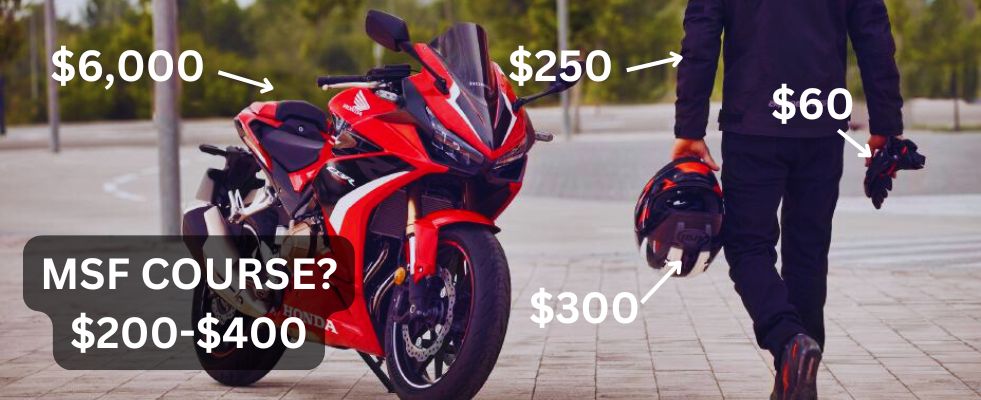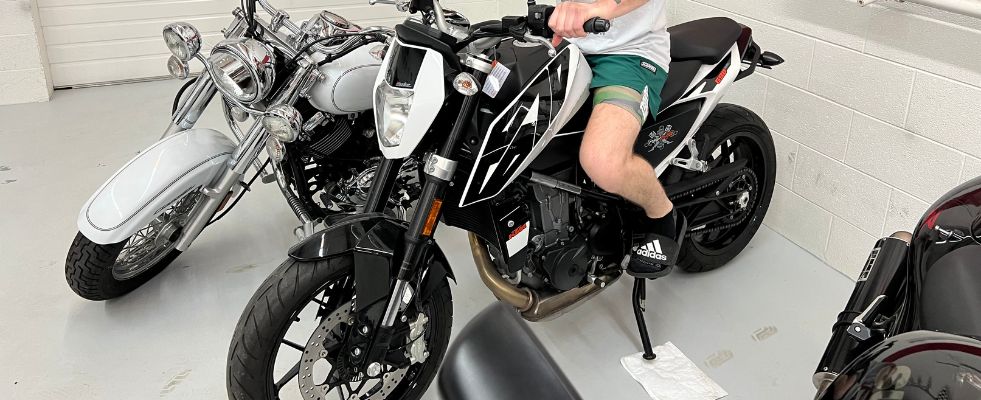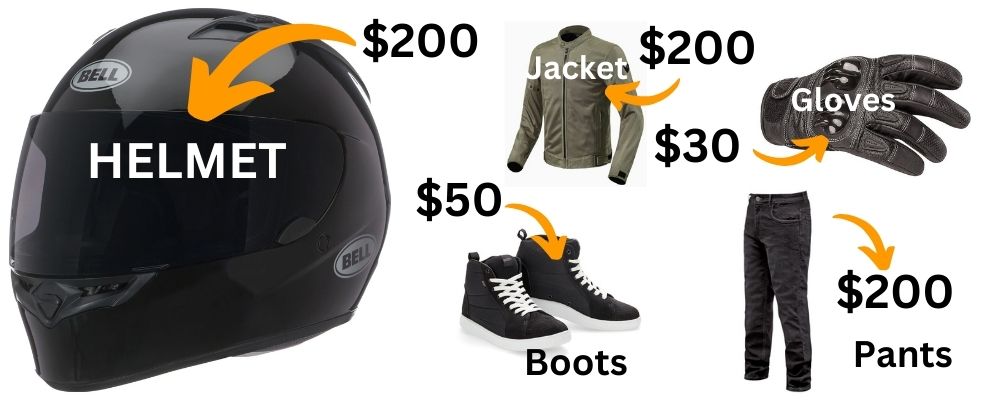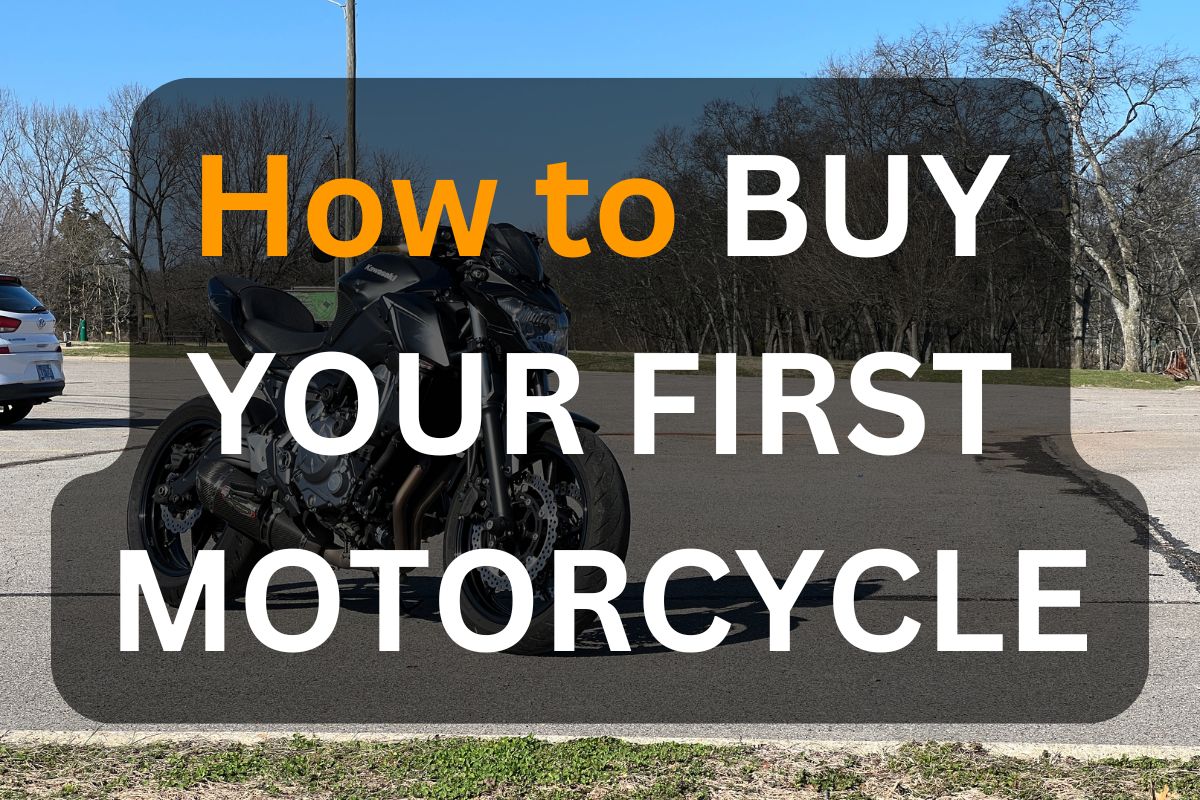Choosing your first motorcycle is a big moment!
The right motorcycle isn’t just about looks or speed; it’s about comfort, control, and safety—things that can boost your confidence every time you get on the road.
A good first bike can make learning fun and help you build the skills that will keep you riding smoothly for years to come.
If you want to see the bikes we recommend, check out our article on the “Top 10 Motorcycles for Beginners“.
What Style of Riding Do You Like?
Knowing how you want to ride is key to finding a motorcycle that will suit your needs and make riding enjoyable from day one.
Different riding styles require different bikes, and each one has its own pros and cons.

City Commuting
If you’re riding mainly in the city, choose a lightweight, agile bike that can handle frequent stops, tight turns, and heavy traffic.
Bikes like standard/naked motorcycles or smaller sport bikes (around 300cc-400cc) are great for urban riders, as they’re easy to maneuver and often have upright seating for better visibility.
Sport Riding
For those who want a bit more speed and performance, beginner-friendly sport bikes (typically in the 300cc-500cc range) offer a balance between agility and control.
Sport bikes are built for speed and quick handling, making them thrilling for twisty roads and track days, but they might not be as comfortable for long rides or daily commuting.
Long-Distance Touring
For long highway journeys, comfort and stability are key.
Touring bikes and cruisers are designed for extended rides with features like relaxed seating positions, cushy seats, and storage for gear.
Their heavier weight makes them stable at high speeds, though they may be harder for beginners to manage at lower speeds.
Off-Road or Adventure Riding
If you’re all about trails and outdoor exploration, look into adventure or dual-sport bikes.
These bikes offer good suspension, rugged tires, and a durable build to handle dirt paths, gravel, and uneven terrain.
They’re versatile, often allowing you to switch between paved roads and trails, but can feel a bit tall and bulky for some new riders.
Defining your riding goals now will help you focus on bikes that match your vision, making it easier to get comfortable, build confidence, and truly enjoy the ride.
Set a Realistic Budget
Buying a motorcycle is exciting, but the bike itself is only part of the total cost.
You can get a good idea of this budget with our article “How to Budget For Your First Motorcycle“.
To get a clear picture of what you’ll spend, you’ll need to factor in essentials like safety gear, licensing, insurance, and regular maintenance.

Key Expenses to Keep in Mind
- Safety Gear
Quality gear is a must. Expect to spend on a DOT-certified helmet, a riding jacket, gloves, boots, and potentially riding pants. Altogether, you’re looking at a starting budget of about $500 to $1,000 for essential gear—worth every penny when it comes to protecting yourself on the road. - Licensing and Insurance
If you don’t already have a motorcycle license, factor in the cost of a course or test. Motorcycle insurance varies depending on the bike type, engine size, and even your location. As a general rule, beginner-friendly bikes with smaller engines are less expensive to insure. - Maintenance
Motorcycles need regular upkeep. Plan for things like oil changes, chain maintenance, tire replacements, and occasional repairs. You might be able to handle some basics yourself, but it’s still smart to set aside at least a couple hundred dollars per year for maintenance.
Financing vs. Buying Outright
When setting your budget, one of the biggest decisions is whether to buy your motorcycle outright or finance it.
Each option has its own advantages, depending on your financial situation and priorities.
For a more detailed breakdown, check out our guide on Financing vs Buying Your First Motorcycle.
Financing a Motorcycle
Financing can make it easier to afford a more expensive or newer bike by spreading out the payments over time.
For beginners, financing can be a good option if you want to start with a reliable, newer bike without paying the full price upfront.
However, keep in mind that with financing, you’ll pay interest over the life of the loan, which adds to the overall cost.
Plus, you’ll need to budget for monthly payments, insurance, and other essentials.
Buying Outright

Paying in full has the advantage of no monthly payments or interest. If you buy a used bike outright, you could save even more on upfront costs. This option is ideal for those who want to keep expenses simple and avoid debt.
However, paying outright may limit you to a lower budget unless you’ve set aside enough savings.
Both options have pros and cons, so think about your budget, how often you plan to ride, and how much flexibility you need.
And don’t forget, there are a few ways you can find deals on motorcycles if you have the patience.
New vs. Used Motorcycles
Deciding between a new or used motorcycle can impact both your upfront and long-term costs.
If you decide to buy used, it’s a good idea to always know how to inspect a used motorcycle properly.
Here’s a quick breakdown of the pros and cons:
New Motorcycles
- Pros: Typically come with warranties, no wear-and-tear issues, and the latest technology and safety features.
- Cons: Higher initial price and quicker depreciation, meaning the bike loses value faster once you ride it off the lot.
Used Motorcycles
- Pros: More affordable upfront, and often with lower insurance rates. If you buy a well-maintained bike, you can get great value.
- Cons: Potentially higher maintenance costs if parts need replacing, and you might not know the full history of the bike.
Overall, setting a budget that includes these factors will help you start riding confidently without straining your finances.
Motorcycle Types for Beginners
Picking the right motorcycle type as a beginner can make a huge difference in comfort, confidence, and control.
Here are some of the best beginner-friendly types and why they’re popular among new riders:

Cruisers
- Best For: Easy, comfortable riding with a relaxed feel.
- What Makes Them Beginner-Friendly:
- Cruisers are known for their low seat height and comfortable, laid-back ergonomics. They’re great for riders who want stability and a relaxed riding position, especially if you’re not too tall or just want to keep both feet firmly on the ground when stopped. The low seat also makes cruisers easy to handle at slow speeds. Popular beginner options include the Honda Rebel and Yamaha V-Star.
Naked Bikes (Standard)
- Best For: All-around versatility, especially for urban and city riding.
What Makes Them Beginner-Friendly:- Naked bikes (or standards) offer a neutral, upright seating position that feels natural and doesn’t strain your wrists or back. They’re lightweight, agile, and come with balanced torque and power—enough for fun, but not overwhelming for a beginner. Standards like the Kawasaki Z400 or Honda CB300R are popular for their ease of control and ability to handle everything from city streets to winding roads.
Dual-Sports
- Best For: Riders looking to mix on-road and off-road adventure.
- What Makes Them Beginner-Friendly:
- Dual-sports are lightweight and durable, with good suspension for bumpy roads and trails. They have balanced ergonomics and power, making them easy to control both on and off the pavement. For new riders who want to explore dirt roads or trails but still need something street-legal, dual-sports like the Honda CRF300L or Kawasaki KLX230 are a great choice.
Choosing a type that matches your riding goals will make getting started easier and more enjoyable. Each of these types has options with manageable power and handling, giving you confidence on the road as you build up your skills.
- Dual-sports are lightweight and durable, with good suspension for bumpy roads and trails. They have balanced ergonomics and power, making them easy to control both on and off the pavement. For new riders who want to explore dirt roads or trails but still need something street-legal, dual-sports like the Honda CRF300L or Kawasaki KLX230 are a great choice.
Choosing a type that matches your riding goals will make getting started.
And if you’re looking for inspiration, check out our article on the “Top 10 Beginner Motorcycles“.
Choosing the Right Engine Size, Power, and Fit
When you’re just starting out, it’s essential to choose a bike with a manageable engine size and a good fit for your body type. This balance will make riding easier and safer, helping you build confidence on the road.

Choosing the Right Engine Size and Power
For beginners, smaller engines between 300cc and 600cc are ideal. These bikes have enough power to get you moving but aren’t overwhelming, especially when you’re still learning.
More power affects handling and acceleration, which can be tricky if you’re new to controlling a motorcycle.
Smaller engine bikes like the Honda Rebel 300 or Kawasaki Ninja 400 offer a great mix of power and control, letting you learn the basics without too much risk.
Why Lower Power is Safer for Beginners
With a lower-power bike, you have more control over acceleration and braking, which is especially important in tricky situations like tight turns or sudden stops.
Higher-power engines can be tempting, but they’re also faster and heavier, making them harder to handle and potentially riskier for new riders.
Getting the Right Fit
Just as important as engine size is finding a bike that feels comfortable and natural for your body type.
The right ergonomics—seat height, handlebar reach, and foot placement—make a big difference in how easy a bike is to control.
For example, if you’re shorter, a low seat height (like on most cruisers) will let you place both feet firmly on the ground, giving you stability when you stop.
Tips for Finding the Right Fit
- Test Seat Height: Aim for a bike where you can touch the ground easily with both feet. This adds confidence, especially in stop-and-go traffic.
- Check Weight: A lighter bike is easier to maneuver and balance, especially at low speeds.
- Consider Adjustments: Many bikes offer basic adjustments, like moving handlebars closer or adjusting the seat height, which can make a big difference in comfort and control.
A bike with the right engine size and fit will make it easier to focus on riding skills and safety, giving you a great start without overwhelming you.
Essential Gear for New Riders
Safety gear isn’t just a checklist—it’s your first line of defense on the road.
Here’s what every beginner should have and how to choose gear that offers the right protection.

Helmet
A helmet is the single most important piece of gear, protecting your head from serious injury in case of a fall or collision.
For a more detailed guide, check out our article on “How to Choose The Best Motorcycle Helmet“.
Opting for a quality helmet can make all the difference in staying safe.
- What to Look For: DOT-certified for safety standards.
- Type: Full-face helmets provide maximum coverage, protecting both your head and face.
Jacket
A durable jacket shields you from abrasions and impact while also providing some weather protection. The right jacket offers both comfort and reinforced protection at critical points.
- What to Look For: Leather or textile materials with CE-rated armor at the elbows, shoulders, and back.
- Weather Options: Consider mesh for hot weather; leather is highly durable for all-around protection.
You can also check out our guide on “How to Choose the Right Motorcycle Jacket“.
Gloves
Gloves protect your hands, which are often the first to hit the ground in an accident.
They also keep your hands comfortable and help with grip, making riding smoother and safer.
- What to Look For: Reinforced palms and knuckle protection for added impact safety.
- Style: Short gloves are fine for city riding, while full gauntlet gloves cover and protect your wrists.
Boots
Boots keep your feet and ankles secure, reducing the risk of injury and providing grip on the bike. Standard shoes can’t provide the same support or safety in a fall, making boots an essential.
- What to Look For: Over-the-ankle design with oil-resistant soles for better grip and control.
- Protection: Reinforced toe and ankle protection to keep your feet safe in the event of a fall.
Starting with these essentials will set you up for safer, more comfortable rides. Look for gear that fits well and meets safety standards, and upgrade as you go.
For a more in-depth look, check out our Guide on The Essential Motorcycle Gear for Riders.
Consider Long-Term Maintenance
Motorcycles, like any vehicle, require regular maintenance to stay safe and running smoothly.
For new riders, it’s helpful to know what basic maintenance involves, as well as some low-maintenance options if you want to keep things simple.

Basic Maintenance and Costs
As a new rider, you’ll want to be aware of these routine tasks and their potential costs:
- Oil Changes: Essential to keep the engine running smoothly; generally required every 3,000-5,000 miles.
- Tire Replacements: Depending on how often you ride, you could end up needing tires every few months or every few years. Check for tread wear to gauge when it’s time.
- Routine Inspections: Basic checks on the chain, brakes, and lights help ensure safe riding and catch any issues before they become serious.
Low-Maintenance Motorcycle Options
Bikes with smaller engines (like 300cc-500cc) and single-cylinder engines tend to need less maintenance.
Additionally, some models, like the Honda Rebel 300 or Yamaha MT-03, are known for reliability and are designed with simplicity in mind, making them solid choices for riders who prefer a low-maintenance setup.
Common Beginner Mistakes and How to Avoid Them
Starting out on a motorcycle can be thrilling, but it’s easy to make mistakes that can hold you back or lead to risky situations.
Here are some common pitfalls that new riders face and how you can avoid them:
Choosing Too Much Power
A powerful bike can be tempting, but starting with a high-powered engine makes handling trickier and increases the risk of accidents.
Instead, opt for a beginner-friendly engine (300cc-600cc) that’s more forgiving and easier to control.
Skipping Safety Courses

Riding a motorcycle is a unique skill set that’s best learned through formal training. Motorcycle safety courses teach essential skills, like handling sharp turns and emergency braking.
Many experienced riders will tell you that a solid foundation from a course will serve you for life.
Neglecting a Budget for Gear
Some beginners focus on the bike itself and overlook the importance of safety gear. Remember that helmets, jackets, gloves, and boots are crucial for your safety.
Make room in your budget for this gear, as it’s as important as the bike itself.
Rushing the Learning Process
Riding takes time to master, and the best riders are those who build skills gradually. Experienced riders emphasize patience and steady skill-building over trying to push limits too quickly.
Take time to practice in safe, low-traffic areas, and gradually build confidence before tackling busy roads or high speeds.
Conclusion
Choosing the right first motorcycle, gear, and riding approach can make all the difference in your experience.
From setting a realistic budget to selecting a manageable engine size and practicing good maintenance habits, every decision helps set you up for safe, enjoyable riding.
Take it one step at a time, invest in your safety, and focus on building skills, and you’ll be well on your way to becoming a confident, capable rider.

